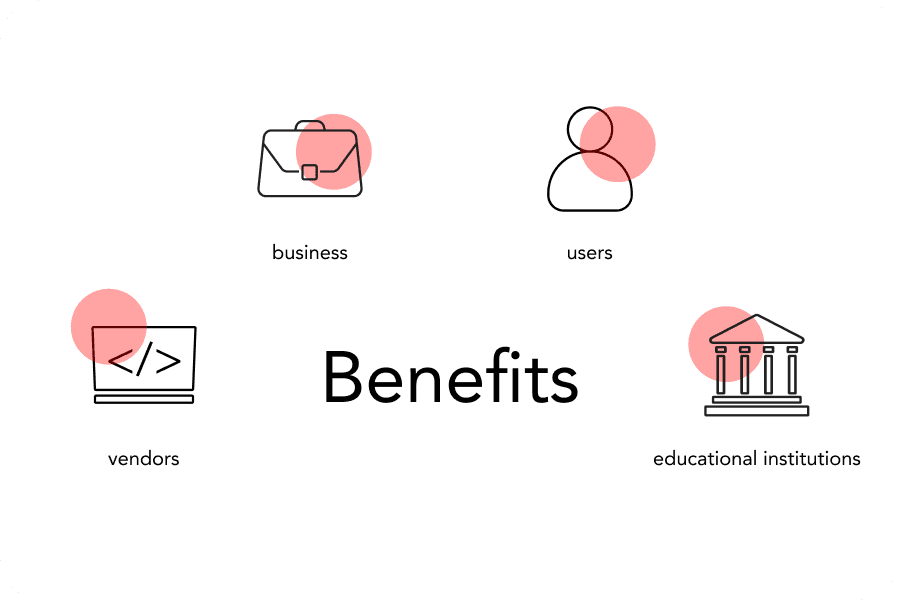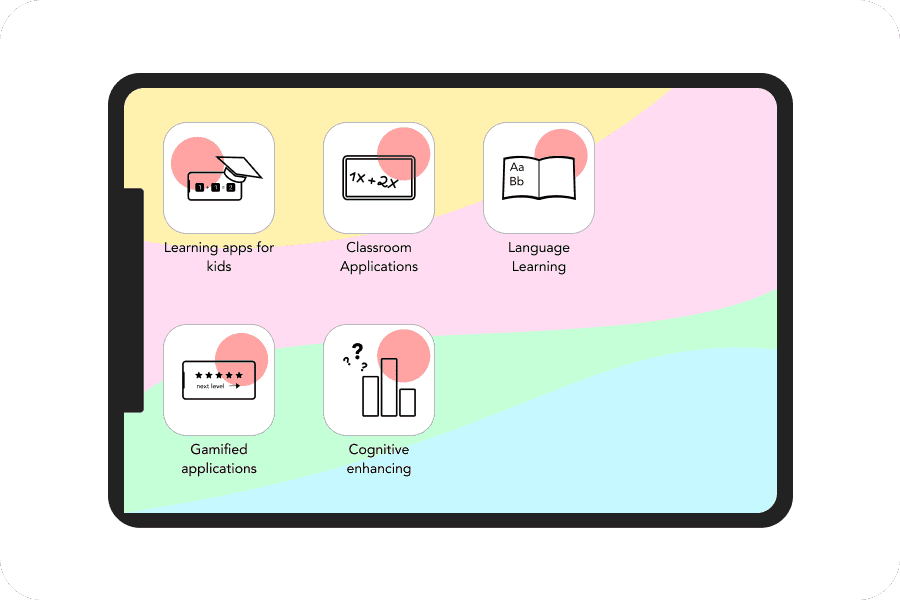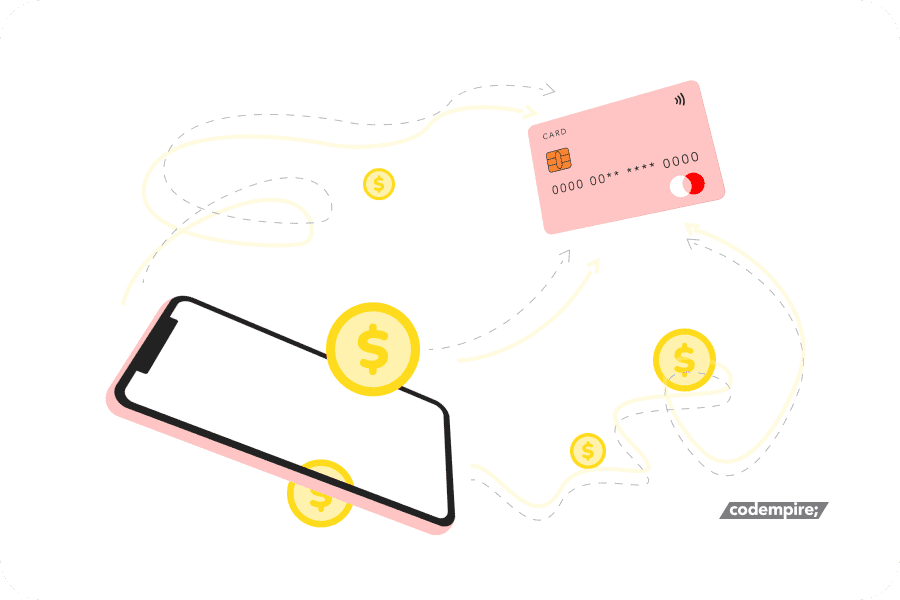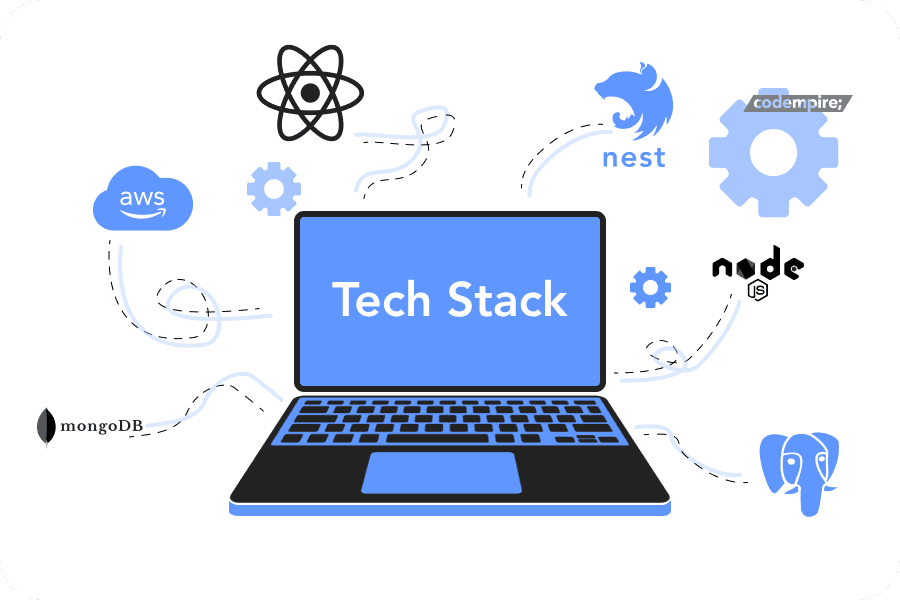How to Develop an Education Application: Guide for Android and iOS
14 min read
Page Content
- 1. Education Apps Industry Overview
- 2. What are the Benefits of Educational Apps
- 3. Existing Types of Apps for Education
- 4. Who Has the Upper Hand in this Market Right Now?
- 5. What Challenges Should You Prepare for?
- 6. Don't Forget About Business Model of Your Startup
- 7. Learning App Features You Can't do Without
- 8. Advanced Features List for Educational App
- 9. What Should You Know About Tech Stack?
- 10. Steps to Develop an Educational App
- 11. The Last But Not Least: How Much Does it Cost to Create an Educational App?
- 12. Conclusion
Employees, schools, business people, and government institutions are beginning to build learning software. Since most users utilize it on their mobile devices, the best way to achieve this is to create an educational app for Android and iOS.
Hiring E-learning App Development Services Company can be the best decision in this case for multiple reasons.
For example, a vendor company takes care of the risks and project organization, so there are no organizational issues to deal with. Smart budgeting, top quality of the code base, distribution of responsibilities, and rich expertise are benefits offered by vendor companies but difficult to find among freelancers.
In the following article, you’ll learn about IOS and Android app development’s main stages, user needs, and audience. As well as the most important features, technical requirements, monetization model, strategies for overcoming obstacles during the course of the project, and cost of developing an educational app.
Education Apps Industry Overview
According to recent research, educational apps are the second most downloaded software in the app store and only second to games in terms of engagement in the Google Play Store. This means that many people are interested in learning for multiple reasons.
According to a study, edtech app organizations recorded a profit of approximately 2.2 billion USD in 2020.
This is why many organizations are investing in creating an educational app for iPhone and other mobile gadgets since most of its users are now learning remotely. Asian, middle -east, and African users are the highest beneficiaries of the learning process due to the incredible number of non-native speakers living there.
Planning an educational app for Android/iOS?
Get Free digital consulting from the expert Discovery Team.
Contact usWhat are the Benefits of Educational Apps

For vendors:
- Most targeted audiences involved in learning programs want to learn remotely, using their mobile device. The best way to meet their needs is to create your own educational android app for iPad, iPhone, or other mobile devices.
- Huge revenue is one of the reasons vendors invest in education apps with gamification attributes.
- It offers salespeople the opportunity to expand their targeted audience and niche. They would be able to meet the needs of healthcare, enterprises, schools, and corporate organizations.
For business:
- It helps to evaluate the efficiency of a company’s employees and processes. Educational apps can perform corporate training to improve the staff’s performance and learning progress.
- One of the ways to improve your business is to create an e-learning app that includes gamification. It can enhance productivity output by reducing stress and burnout. A recent study shows that about 66% of the participants in a survey felt energized after using a learning app with games.
For educational institutions:
- Educational app helps to shorten the cost spent on teachers and classrooms. Virtual learning is also time adequate since it is online, and no time is needed to get to the learning venue.
- Investing in education application development is the best way to motivate learners to participate in virtual training. It becomes more accessible for people to be interested since it is online.
- Virtual learning increases the number of participants by solving problems such as transportation, work schedule, and planning. Learners can connect quickly and get more acquainted with the learning materials. It is possible to reach all age groups by developing an educational app with a good design for kids.
For users:
- Unlimited access. Online education provides the users with the opportunity to learn anywhere and time, using any device.
- E-learning applications equip users with all the features and resources needed for proper skill enhancement.
- Employees, students, and people in business can assess and improve their language progress through online learning.
- Educational products often contain features or and tools such as lessons, quizzes, assignments, interactive sessions, and games that help to improve critical reasoning and problem-solving skills.
Investing in educational app development is one of the best ways to maximize these learning platforms.
Want to maximize profit from an educational app?
Our experienced team will guide you on budgeting and monetization issues for free.
Contact usExisting Types of Apps for Education

Learning apps for kids
Language learning has to be entertaining and engaging to attract children. Kids are known for their curiosity and high visual appeal. It is easier to learn many languages at a younger age, but the big problem is getting an app that interests young learners. The common application for kids are:
- Quick Math Jr. Quick Math is an application that helps users improve their arithmetic skills through detailed explanations.
- Epic. It is famous because most kids see it as a virtual library for learning fun and new information.
- ABC mouse. Music and art lovers enjoy using ABC learning apps to enhance their skills.
Children are attracted to any app that satisfies their curiosity, has great design, and is visually appealing. Making an educational mobile app that helps kids learn is a way to maximize revenue from the educational sector.
Classroom Applications
Learning platforms can serve as a virtual classroom for teachers to organize their learning materials and process. It could also be used for remote learning through cloud-based applications. The most common classroom apps are Kahoot, Classtree, and Google Classroom. Kahoot is a platform that uses quizzes and games to improve its users. Google Classroom is an app that connects tutors and learners online. These are good examples to mimic when wondering how to develop an educational app that works for both adults and kids.
Language Learning Applications
Some software focuses primarily on language learning. LinguaLift, Memrise, and Duolingo are the most popular apps for learning different languages. They consist of varying skill tracking features and programs to make the user’s learning experience smooth and quick. Memrise is learning software that keeps users engaged by using repetitive mnemonics and videos to improve their language skills. Duolingo offers a preliminary entrance test to know the language level of its user and plan a course outline based on the result. Duolingo is a good example if you want to If you are planning to build an educational app.
Cognitive enhancing applications
This app enhances the logical learning skills of its users by using various pictorial representations such as bar charts and graphics. This method increases the ability of learners to think critically, faster, and concentrate more. Brain testing apps are suitable for students that love mnemonics and want to improve their attention span. This type of app is vital for developers that plan to build mobile applications for education.
Gamified applications
Integration of gaming and learning features into one app can widen the targeted audience. This ensures that the software can help users of different ages and learning needs. Parents prefer Kahoot and ClassDojo for adding games to the learning experience offered by the app. Primary school students prefer to use ClassDojo because of its simplicity and gaming features.
It is essential to know the existing type of apps for your idea before deciding on how to start an online learning platform.
Who Has the Upper Hand in this Market Right Now?
There are many top apps in the educational sector, depending on their function category. They include:
- Duolingo and Babbel, are the leading language learning apps in the market.
- Socratic, which is the most frequently used app by Scholars. It is an alternative to Google search. Users use it to learn academic-related topics.
- Kahoot - the leading gamification learning app due to its fun quizzes and features.
- Epic is the preferred choice by parents for their kids to learn online.
- Picture. This is an application that improves the learning experience of its users through diagrams.
- Google classroom - a popular virtual learning app connecting students and teachers online.
- ABC Mouse. It is an educational app for kids that offers music, art, reading, and mathematics. It works for children regardless of their age group.
- Mathway and Photomath, are the most popular math-solving applications in the educational sphere. They are widely used due to their detailed and easy-to-understand explanations of the subject.
Identifying the leading software is crucial when deciding how to build an education app that would be lucrative and help all targeted audiences.
Want to create a leading application?
Our discovery team will share technical expertise to bring your solution to the top.
Contact usWhat Challenges Should You Prepare for?

User needs
It is vital to conduct target audience analysis using software like Google Analytics. The product owner can also get help from a professional discovery team.
Wrong Method selection
Selecting the correct method can help you get the best out of your technology stack and app development process. Scrum and Agile are the most efficient approaches for your project. Working in sprints and milestones helps to improve organization accountability and reduce the margin for error and missing deadlines. CI/CD is an excellent way to maintain frequent communication between developers and clients.
Inadequate scoping
Planning, budgeting, and scoping are the most vital factors in mobile learning app development. Experienced professionals will be able to determine the timing and budget more accurately, which will help to avoid overpayments and delays.
Lack of experts
Assembling the right technical team is compulsory for building a world-class app. You must verify the developers’ expertise by looking at their portfolios and past work. It is easier to scale and modify your code when written by a professional. Your processes and communication will be more efficient.
Protection policies
Learners want protected data and unique learning content. Educational platforms need to have anti-theft and data protection policies on their applications. This can be achieved by adding advanced encryption, watermarking, SSL certificates, and double-step authorization.
Underestimating Rivals
Google Analytics and consistent feedback mechanisms are the potent ways of performing market and competitor analysis. This will allow the developers to analyze the products and check if they align with the client’s goals. The suggestions received from the investor, users, or buyers can help in risk management, improvement, and planning.
Don’t Forget About Business Model of Your Startup

Subscription model
A paid subscription is used by many language apps such as Drops. It involves monthly, yearly, or lifetime subscriptions for an education program.
Freemium
Duolingo uses this monetization strategy and gets funding from the government, donations, public sectors, foundations, and regular users.
Supplementary services
It is also possible to make more revenue by charging for extra services with the app. For example, a website can offer the courses for free but charge for the exercises.
Application adverts
Advertisements are another way to make your app lucrative. You can get paid for every advert on your software.
Selecting the right business model is vital during android education app development.
Learning App Features You Can’t do Without
Admin panel
The admin dashboard of the platform is crucial for monitoring course, purchase, skills, and user account. The product owner needs to have full access to the content and rights of the software. The type of admin panel depends on the application size. Most organizations use a simple or complex admin board to manage their marketplace.
User panel
The user account should contain skill checking tools, discounts on all in-app purchases, certificates, game achievements, etc. The user’s learning experience can also be improved by selecting their teachers, avatar, and learning schedule. Push notifications, animation, and others interactive features can increase traffic to your learning app and increase revenue.
Simplified searching tools
If your goal is to build a top LMS, MOOC, searching for information efficiently is compulsory. This can be achieved by enabling search filter options. Users should find information using the authors’ names, courses, languages, ratings, etc. Suggestive pop-ups and notifications are another way to help authors and students find information quickly. The pop-up can help auto-complete the inquiry by using previously explored data.
Flexible payment options
App monetization can be made easier with flexible payment plans. The top educational apps work with all bank cards, PayPal, Apple pay, Google Pay, and other payment options to make revenue generation easy.
Consistent feedback and rating system
A chatbot that replies to customers’ FAQs can help meet users’ needs, push notifications, animation, and other interactive features can increase traffic and revenue of your learning app. The response received can generate automatic suggestive search options for learners. It is helpful to rate students based on skills and performance for motivation. This helps to improve Learning performance.
Video Conferencing tools
Distant learning is only possible through video calls. You can partner with ZOOM, Google meets, or create your customized videoconference technology.
Advanced Features List for Educational App

Uninterrupted learning
Our experienced developers can create applications that work with Android, iOS, and other platforms. This gives your users uninterrupted access to the learning program.
Real-time learning
Your users need to have access to your app in real-time, especially when equipped with gamification features. Codempire has rich expertise in developing an app with gamification features that many users can play at once in real-time.
Content customization
The content creator should have the ability to customize the learning content using different plugins. Features such as translation of a text, highlighting essential features, fast download of learning materials can improve the efficiency of learning.
Social networks authorization
It would be beneficial if your application offered social media authorization. This would ensure smooth access for all the app users. The information received from the social network can also fill the student’s profiles.
Community
A good learning app should include a community platform that encourages chats, party videos, audio, feedback, and video conferencing tools between its participants. Our developers have vast experience in building software with solid community support.
Gamification
Adding features such as quizzes, games, and other forms of interaction can keep adult learners motivated and increase children’s engagement. Your application can stand out if you combine learning and run-through gamification in your learning program.
Need an expert opinion on mandatory features?
Our highly trained team will guide you in decision-making.
Contact usWhat Should You Know About Tech Stack?

Frontend
React and React Native make it possible to have a single codebase that can be useful for cross-platform app development. It is both reusable and modifiable. As a result, by developing software for all platforms at the same time, the product owner saves labor resources, financial resources, and time.
Backend
Node.Js integrated with NestJs framework is a scalable tech stack with high flexibility to speed ratio. It is a good choice during the MVP stage, especially if you prioritize growth and plan to avoid overloading during the implementation process.
Database
Every educational app needs to have top priorities for its project. PostgreSQL is an example of a relational database that focuses on information security. Non-relational databases such as MongoDB are primarily used because they are fast and flexible. Select a database choice that suits your project goal.
Cloud Support
Most startup organizations take advantage of the 1-year loyalty bonus for new applications offered by AWS. Using AWS is more effective when working on multiple projects.
Looking for the perfect tech stack?
Personal consultation with our team will help you to make the best choice.
Contact usSteps to Develop an Educational App
- Discover your prospective clients and audience. Knowing your intending students’ age, gender, location, proficiency, and learning motives is advisable. Plan how your application would offer a way out of the people’s challenges.
- Have a draft of your project idea, including all the features and technical aspects required for the application. Find out which audience your concept can help and how it solves their needs.
- Analyze the targeted market and competitors. Make a plan on the resources and features needed to be unique or better than your rivals.
- Create a budget and marketing strategy.
- Partner with an experienced e-learning development company with a team of professionals to help build your application.
- Prototyping stage.
- Creating an MVP. This can help you get opinions for improving the project and as a tool to convince investors about your idea.
- Deployment.
The steps are essential if you wonder how to make an educational app for android.
The Last But Not Least: How Much Does it Cost to Create an Educational App?
| Stages | MVP hours ~950 - 1250 |
Full-fledged hours ~1700 - 2150 |
|---|---|---|
| QA | 30-50 hours per platform |
60-90 hours per platform |
| Backend development | 300-400 hours | 500-700 hours |
| IOS/Android development | 200-250 hours per platform |
400-450 hours per platform |
| UI/UX | 60-80 hours per platform |
90-120 hours per platform |
| Technical Specification | 20-30 hours | 40-50 hours |
| Business Analysis+UX | 50-60 hours | 60-80 hours |
The table above shows the overall hours spent during cross-platform app development. Generally, the cost of hiring a Ukrainian developer is three times lower than their American counterparts that charge approximately 80 USD per hour. With about 30 USD per hour, you can hire an experienced Ukrainian developer with good coding skills to support and develop your mobile app idea.
Conclusion
- Educational apps are very lucrative and the second most downloaded software in the app store. Non-native speakers, especially in Africa, are the most frequent users of these applications. Due to the fast-changing world, most people prefer to learn on platforms compatible with Android and iOS.
- Learning apps provide numerous benefits to users, universities, businesses, and vendors.
- Duolingo, Babbel, Socratic, Kahoot, Epic, Picture This, Google Classroom, ABC mouse, and Mathway are among the favorite learning apps for people of different age groups.
- The common challenges faced by developers and product owners include meeting the customer’s need, wrong choice of methodology planning and scoping mistakes, a lack of expertise, security issues, underestimating the analysis stage. Solving these challenges would ensure your app becomes global and booming.
- The business model for your app can be a subscription model, freemium, supplementary service, and application advert,s depending on your project goal.
- There are mandatory advanced features such as customization, social media integration, gamification, and community support. These elements increase the engagement of customers.
- It is cheaper to hire a Ukrainian developer for your project at the rate of 30 USD per hour without compromising the quality of your mobile application.
#MVP
#e-learning